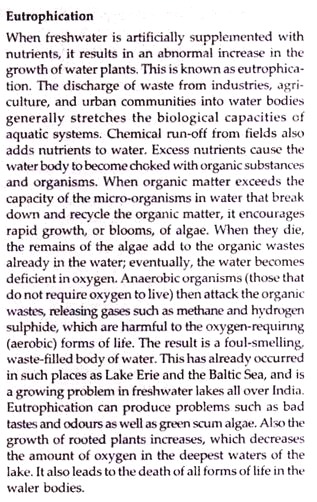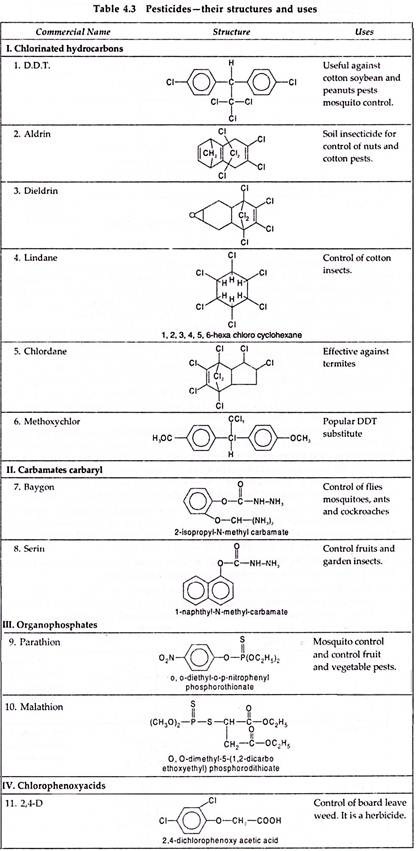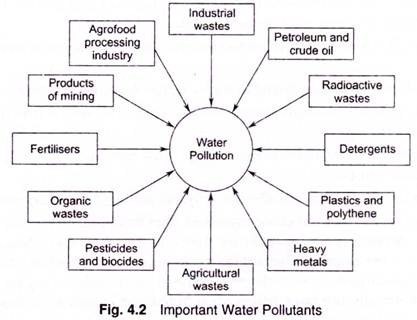Here is an essay on the ‘Causes of Water Pollution’ for class 7, 8, 9, 10, 11 and 12. Find paragraphs, long and short essays on the ‘Causes of Water Pollution’ especially written for school and college students.
Causes of Water Pollution
Essay Contents:
- Essay on Domestic Sewage
- Essay on Agricultural Run-Off
- Essay on Industrial Effluents
- Essay on Oil Spills
- Essay on Groundwater Contaminants
- Essay on Chemicals
- Essay on Corals
Essay # 1. Domestic Sewage:
Domestic Sewage refers to wastewater that is discarded from households. Also referred to as sanitary sewage, such water contains a wide variety of dissolved and suspended impurities. It amounts to a very small fraction of the sewage by weight. But it is large by volume and contains impurities such as organic materials and plant nutrients that tend to rot. The main organic materials are food and vegetable waste, plant nutrient come from chemical soaps, washing powders, etc.
Domestic sewage is also very likely to contain disease-causing microbes. Thus, disposal of domestic wastewater is a significant technical problem. Sewage generated from the urban areas in India has multiplied manifold since 1947. Today, many people dump their garbage into streams, lakes, rivers, and seas, thus making water bodies the filial resting place of cans, bottles, plastics, and other household products. The various substances that we use for keeping our houses clean add to water pollution as they contain harmful chemicals.
In the past, people mostly used soaps made from animal and vegetable fat for all types of washing. But most of today’s cleaning products are synthetic detergents and come from the petrochemical industry. Most detergents and washing powders contain phosphates, which are used to soften the water among other things. These and other chemicals contained in washing powders affect the health of all forms of life in the water.
Essay # 2. Agricultural Run-Off:
The use of land for agriculture and the practices followed in cultivation greatly affect the quality of groundwater. Intensive cultivation of crops causes chemicals from fertilizers (e.g., nitrate) and pesticides to seep into the groundwater, a process commonly known as leaching.
Routine applications of fertilizers and pesticides for agriculture and indiscriminate disposal of industrial and domestic wastes are increasingly being recognized as significant sources of water pollution. The high nitrate content in groundwater is mainly from irrigation run-off from agricultural fields where chemical fertilizers have been used indiscriminately.
Essay # 3. Industrial Effluents:
Wastewater from manufacturing or chemical processes in industries contributes to water pollution. Industrial wastewater usually contains specific and readily identifiable chemical compounds. During the last fifty years, the number of industries in India has grown rapidly. But water pollution is concentrated within a few subsectors, mainly in the form of toxic wastes and organic pollutants. Out of this a large portion can be traced to the processing of industrial chemicals and to the food products industry.
In fact, a number of large and medium- sized industries in the region covered by the Ganga Action Plan do not have adequate effluent treatment facilities. Most of these defaulting industries are sugar mills, distilleries, leather processing industries, and thermal power stations. Most major industries have treatment facilities for industrial effluents. But this is not the case with small-scale industries, which cannot afford enormous investments in pollution control equipment as their profit margin is very slender.
Essay # 4. Oil Spills:
Among the most dangerous of all water pollutants is fuel oil. Oil spills from tankers at sea or leaks from underground storage tanks on land are very difficult to control as oil tends to spread very fast, affecting a large area in a very short time. They are a major menace to the environment as they cause severe damage to surrounding ecosystems. Oil spills at sea decrease the oxygen level in the water and cause grave harm to the creatures living in the sea.
Since crude oil is lighter than water, it floats on the surface and poses the threat of swift-spreading fire. Oil spills are rather common as oil tankers can meet with accidents either in deep sea or offshore, while waiting to be loaded or unloaded. During the Gulf War, several oil reservoirs were destroyed at sea and the effect on marine life was devastating. Seabirds and fish were washed ashore, their bodies covered with oil. On land crude is transported through pipelines or tankers which can get damaged and spew out crude oil over the land, thereby contaminating it.
Essay # 5. Groundwater Contaminants:
Many areas of groundwater and surface water are now contaminated with heavy metals, POPs (Persistent Organic Pollutants), and nutrients that have an adverse effect on health. Water-borne diseases and water-caused health problems are mostly due to inadequate and incompetent management of water resources.
Safe water for all can only be assured when access, sustainability, and equity can be guaranteed. Access can be defined as the number of people who are guaranteed safe drinking water and sufficient quantities of it. There has to be an effort to sustain it, and there has to be a fair and equal distribution of water to all segments of the society.
Urban areas generally have a higher coverage of safe water than the rural areas. Even within an area there is variation; areas that can pay for the services have access to safe water whereas areas that cannot pay for the services have to make do with water from hand pumps and other sources.
In the urban areas water gets contaminated in many different ways, some of the most common reasons being leaky water pipe joints in areas where the water pipe and sewage line pass close together. Sometimes the water gets polluted at source due to various reasons and mainly due to inflow of sewage into the source. Ground water can be contaminated through various sources and some of these are mentioned below.
Pesticides:
Run-off from farms, backyards, and golf courses contain pesticides such as DDT that in turn contaminate the water. Leechate from landfill sites is another major contaminating source. Its effects on the ecosystems and health are endocrine and reproductive damage in wildlife. Groundwater is susceptible to contamination, as pesticides are mobile in the soil. It is a matter of concern as these chemicals are persistent in the soil and water.
Sewage:
Untreated or inadequately treated municipal sewage is a major source of groundwater and surface water pollution in the developing countries. The organic material that is discharged with municipal waste into the watercourses uses substantial oxygen for biological degradation thereby upsetting the ecological balance of rivers and lakes. Sewage also carries microbial pathogens that are the cause of the spread of disease.
Nutrients:
Domestic wastewater, agricultural run-off, and industrial effluents contain phosphorus and nitrogen, fertilizer run-off, manure from livestock operations, which increase the level of nutrients in water bodies and can cause eutrophication in the lakes and rivers and continue on to the coastal areas.
The nitrates come mainly from the fertilizer that is added to the fields. Excessive use of fertilizers cause nitrate contamination of groundwater, with the result that nitrate levels in drinking water is far above the safety levels recommended. Good agricultural practices can help in reducing the amount of nitrates in the soil and thereby lower its content in the water.
Synthetic Organics:
Many of the 100,000 synthetic compounds in use today are found in the aquatic environment and accumulate in the food chain. POPs or Persistent Organic Pollutants, represent the most harmful element for the ecosystem and for human health, for example, industrial chemicals and agricultural pesticides. These chemicals can accumulate in fish and cause serious damage to human health. Where pesticides are used on a large-scale, groundwater gets contaminated and this leads to the chemical contamination of drinking water.
Acidification:
Acidification of surface water, mainly lakes and reservoirs, is one of the major environmental impacts of transport over long distance of air pollutants such as sulphur dioxide from power plants, other heavy industry such as steel plants, and motor vehicles. This problem is more severe in the US and in parts of Europe.
Essay # 6. Chemicals:
Chemicals in water can be both naturally occurring or introduced by human interference and can have serious health effects:
(i) Fluoride:
Fluoride in the water is essential for protection against dental caries and weakening of the bones, but higher levels can have an adverse effect on health. In India, high fluoride content is found naturally in the waters in Rajasthan.
(ii) Arsenic:
Arsenic occurs naturally or is possibly aggravated by over powering aquifers and by phosphorus from fertilizers. High concentrations of arsenic in water can have an adverse effect on health. A few years back, high concentrations of this element was found in drinking water in six districts in West Bengal.
A majority of people in the area was found suffering from arsenic skin lesions. It was felt that arsenic contamination in the groundwater was due to natural causes. The government is trying to provide an alternative drinking water source and a method through which the arsenic content from water can be removed.
(iii) Lead:
Pipes, fittings, solder, and the service connections of some household plumbing systems contain lead that contaminates the drinking water source.
(iv) Recreational use of Water:
Untreated sewage, industrial effluents, and agricultural waste are often discharged into the water bodies such as the lakes, coastal areas and rivers endangering their use for recreational purposes such as swimming and canoeing.
(v) Petrochemicals:
Petrochemicals contaminate the groundwater from underground petroleum storage tanks.
(vi) Other Heavy Metals:
These contaminants come from mining waste and tailings, landfills, or hazardous waste dumps.
(vii) Chlorinated Solvents:
Metal and plastic effluents, fabric cleaning, electronic and aircraft manufacturing are often discharged and contaminate groundwater.
Disease Causing Chemicals:
Water-borne diseases are infectious diseases spread primarily through contaminated water. Though these diseases are spread either directly or through flies or filth, water is the chief medium for spread of these diseases and hence they are termed as water-borne diseases. Most intestinal (enteric) diseases are infectious and are transmitted through faecal waste. Pathogens — which include virus, bacteria, protozoa, and parasitic worms — are disease-producing agents found in the faeces of infected persons. These diseases are more prevalent in areas with poor sanitary conditions.
These pathogens travel through water sources and interfuses directly through persons handling food and water. Since these diseases are highly infectious, extreme care and hygiene should be maintained by people looking after an infected patient. Hepatitis, cholera, dysentery, and typhoid are the more common water-borne diseases that affect large populations in the tropical regions.
A large number of chemicals that either exist naturally in the land or are added due to human activity dissolve in the water, thereby contaminating it and leading to various diseases.
(i) Pesticides:
The organophosphates and the carbonates present in pesticides affect and damage the nervous system and can cause cancer. Some of the pesticides contain carcinogens that exceed recommended levels. They contain chlorides that cause reproductive and endocrinal damage.
(ii) Lead:
Lead is hazardous to health as it accumulates in the body and affects the central nervous system. Children and pregnant women are most at risk.
(iii) Fluoride:
Excess fluorides can cause yellowing of the teeth and damage to the spinal cord and other crippling diseases.
(iv) Nitrates:
Drinking water that gets contaminated with nitrates can prove fatal especially to infants that drink formula milk as it restricts the amount of oxygen that reaches the brain causing the ‘blue baby’ syndrome. It is also linked to digestive tract cancers. It causes algae to bloom resulting in eutrophication in surface water.
(v) Petrochemicals:
Benzene and other petrochemicals can cause cancer even at low exposure levels.
(vi) Chlorinated Solvents:
These are linked to reproduction disorders and to some cancers.
(vii) Arsenic:
Arsenic poisoning through water can cause liver and nervous system damage, vascular diseases and also skin cancer.
(viii) Other Heavy Metals:
Heavy metals cause damage to the nervous system and the kidney, and other metabolic disruptions.
(ix) Salts:
It makes the freshwater unusable for drinking and irrigation purposes.
Exposure to polluted water can cause diarrhoea, skin irritation, respiratory problems, and other diseases, depending on the pollutant that is in the water body. Stagnant water and other untreated water provide a habitat for the mosquito and a host of other parasites and insects that cause a large number of diseases especially in the tropical regions. Among these, malaria is undoubtedly the most widely distributed and causes most damage to human health.
Preventive Measures:
Water-borne epidemics and health hazards in the aquatic environment are mainly due to improper management of water resources. Proper management of water resources has become the need of the hour as this would ultimately lead to a cleaner and healthier environment.
In order to prevent the spread of water-borne infectious diseases, people should take adequate precautions. The city water supply should be properly checked and necessary steps taken to disinfect it. Water pipes should be regularly checked for leaks and cracks. At home, the water should be boiled, filtered, or other methods and necessary steps taken to ensure that it is free from infection.
Minamata: Environmental Contamination with Methyl Mercury:
In Minamata, Japan, inorganic mercury was used in the industrial production of acetaldehyde. It was discharged into the nearby bay as wastewater and was ingested by organisms in the bottom sediments. Fish and other creatures in the sea were soon contaminated and eventually residents of this area who consumed the fish suffered from MeHg (methyl mercury) intoxication, later known as the Minamata disease. The disease was first detected in 1956 but the mercury emissions continued until 1968. But even after the emission of mercury stopped, the bottom sediment of the polluted water contained high levels of this mercury.
Various measures were taken to deal with this disease. Environmental pollution control, which included cessation of the mercury process; industrial effluent control, environmental restoration of the bay; and restrictions on the intake of fish from the bay.
This apart research and investigative activities were promoted assiduously, and compensation and help was offered by the Japanese Government to all those affected by the disease. The Minamata disease proved a turning point, towards progress in environment protection measures. This experience clearly showed that health and environment considerations must be integrated into the process of economic and industrial development from an early stage.
Essay # 7. Corals:
Corals are small, sedentary marine animals that occur in dense colonies in warm shallow waters of oceans. Reef-building corals are scattered throughout the tropical and subtropical western Atlantic and Indo-Pacific oceans, generally between 30 degrees North and 30 degrees South latitudes.
Coral reefs are formed by the skeleton remains of many generations of stony corals. Massive reef structures are built over thousands of years by tiny coral polyps aided by minute algae (zooxanthellae) that live in their tissues, calcifying algae, and other organisms that secrete calcium carbonate and adhesives.
Reef-building corals are generally found at depths of less than 46 m, where there is sunlight and clear water through which the sunlight penetrates better. Reef-building corals, along with the algae, require warm ocean temperatures (20-28° C) and are therefore found along the eastern shores of major land masses where the water is warmer. These reefs are amongst the earth’s oldest living communities of plants and animals. They vary in shape, size and colour.




